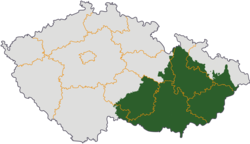
Moravia (Czech and Slovak: Morava, German: Mähren, Polish: Morawy, Hungarian: Morvaország) is an historical region in the east of the Czech Republic. It takes its name from the River Morava which rises in the north-west of the region.

Moravia (Czech and Slovak: Morava, German: Mähren, Polish: Morawy, Hungarian: Morvaország) is an historical region in the east of the Czech Republic. It takes its name from the River Morava which rises in the north-west of the region.
Moravia occupies most of the eastern third of the Czech Republic including the South Moravian Region and the Zlín Region, as well as parts of the Moravian-Silesian, Olomouc, Pardubice, Vysocina and South Bohemian regions.
In the north, Moravia borders Poland and Czech Silesia; in the east, Slovakia; in the south, Lower Austria; and in the west, Bohemia. Its northern boundary is formed by the Sudetes mountains which become the Carpathians in the east. The meandering Thaya flows through the border country with Austria and there is a protected area on both sides of the border in the area around Hardegg.
At the heart of the country lie the sedimentary basins of the Morava and the Thaya at a height of 180 to 250 m. In the west, the Bohemian-Moravian Heights rise to over 800 m although the highest mountain is in the north-west, the Praděd (German: Altvater) in the Sudetes at 1490 m. Further south lie the Jeseníky highlands (400 to 600 m) which fall to 310 m at the upper reaches of the River Oder (the Moravian Gate) near Hranice na Moravě and then rise again as the Beskids to the 1322 m high Lysá hora (German: Kahlberg). These three mountain ranges plus the "gate" between the latter two form part of the European Watershed. Moravia's eastern boundary is formed by the White Carpathians which reach a maximum of 970 m at Velká Javořina.
In the south around Hodonín and Břeclav the land is part of the Viennese Basin and petroleum and lignite are drilled for in its deeper sediments. In the area around Ostrava there was intensive coal mining until around 1995. Iron, chemicals, leather and building materials are the main industrial goods. The main economic centres are Brno, Olomouc and Ostrava. As well as other agriculture, Moravia is noted for its viticulture.
Around 60 BC the Celtic Boii people withdrew from the region and were succeeded in turn by the Germanic Quadi and in the 6th century the Slavic tribes. At the end of the 8th century the Moravian Principality came into being in present-day south-eastern Moravia, Záhorie in south-western Slovakia and parts of Lower Austria. In 833 this became the state of Great Moravia with the conquest of the Nitrian Principality (present-day Slovakia and parts of northern Hungary). Great Moravia went on to encompass neighbouring Bohemia, Hungary, Lusatia, Silesia and the Vistula Basin.
This empire however fell in the face of invading Magyars around 907. Present-day Moravia was then independent for a period before possibly coming under the control of Bohemia in 955. Between 999 and 1019 the land was under the rule of Boleslaus I of Poland before becoming part of Bohemia in 1019. It was raised to the status of a margraviate (or mark) in 1182 and has since then shared its history with Bohemia, coming under the rule of the House of Luxembourg between 1349 and 1411 and then under Habsburg rule.
Until 1641 Moravia's capital was the centrally-located Olomouc, after which it moved to the larger city of Brno. The Margaviate of Moravia had its own "zemský sněm" or Landtag (diet) whose deputies were elected (in the years following 1905) in ethnically separate German and Czech constituencies.
Following the break-up of the Austro-Hungarian Empire in 1918, Moravia became part of Czechoslovakia (and was part of the Protectorate of Bohemia and Moravia during the German occupation of Czechoslovakia in World War II). In 1945 the ethnic German minority of Moravia were expelled. (See Expulsion of Germans after World War II). With the break up of Czechoslovakia, Moravia became a part of the Czech Republic in 1993.
The Moravians today are a Slavic ethnic group that speaks various dialects of Czech. Some Moravians regard themselves as an ethnically distinct group, others consider themselves to be ethnically Czech. In the census of 1991 1,362,000 (13.2%) of the Czech population described themselves as being of Moravian nationality. In the census of 2001 this number had decreased to 380,000 (3.7% of the population).
Sigmund Freud was born in Freiberg, Moravia (now Pribor, Czech Republic) on May 6, 1856.
Much of the content of this article comes from the equivalent German-language Wikipedia article as of August 29 2005.
Template:Link FA